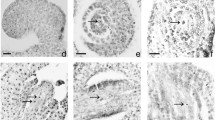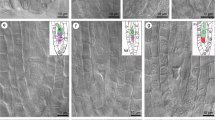Abstract
The megasporogenesis and microsporogenesis, development of male and female gametophytes, pollen morphology and changes of anther wall structure during pollen development and ovary wall structure during ovule development in Liriope spicata (Thunberg) Loureiro of genus Liriope Loureiro in family Ruscaceae Spreng were studied using paraffin sections, scanning electron microscopy and fluorescence microscopy. The main results can be concluded as follows: 1) the cytokinesis of microsporocyte is successive; 2) the tetrads of microspores are mostly symmetrical and occasionally tetrahedral; 3) the mature pollen grain is oval or oblong, 2- or 3-celled, and has a sulcus and a rugulate–perforate ornamentation; 4) anther wall is of monocot type with secretory tapetum; 5) ovary is superior and has axial placentation and anatropous, bitegmic ovule; 6) the tetrads of megaspores are arranged most in a straight line and occasionally in T-shape; 7) the megaspore at the chalazal end develops into a functional megaspore; 8) development of embryo sac is of the polygonum type; 9) the floral morphology of both genera Liriope Loureiro and Ophiopogon Ker Gawler supports that each of them should be an independent genus.






Similar content being viewed by others
References
APG III (2009) An update of the Angiosperm Phylogeny Group classification for the orders and families of flowering plants: APG III. Bot J Linn Soc 161:105–121
Bailey LH (1929) The case of Ophiopogon and Liriope. Gentes Herbarum 2(1):3–37
Bentham G, Hooker JD (1883) Haemodoraceae. Genera plantarum, vol 3(2). Reeve, London, pp 636–740
Broussard MC (2007) A horticultural study of Liriope and Ophiopogon: nomenclature, morphology, and culture. Master Thesis, Louisiana State University
Chen SC, Tamura MN (2000) Liriope. Flora of China, vol 24. Science Press/Missouri Botanical Garden Press, Beijing/St. Louis, pp 250–251
Conran JG, Tamura MN (1998) Convallariaceae. The families and genera of vascular plants, vol 3. Springer, Berlin, pp 186–198
Cutler DF (1992) Vegetative anatomy of Ophiopogon (Convallariaceae). Bot J Linn Soc 110:385–419
Davis GL (1966) Systematic embryology of the angiosperms. Wiley, New York
Deputy J (1999) Liriope, the “Other” Mondo Grass. Ornam Flowers 29:1–4
Devine R (1997) Asian carpets. Am Nurserym 185:58–62
Du J (2003) Study on the content and the oral acute toxicity of polysaccharide pill from Chinese traditional medicine Radix liriopes. J Hubei Univ (Nat Sci Edn) 25(4):350–352
Fantz PR (1993) Taxonomic problems in cultivated liriopogons. HortTechnology 3(2):146–150
Fantz PR (2008a) Species of Liriope cultivated in the southeastern United States. HortTechnology 18(3):343–348
Fantz PR (2008b) Macrophytography of cultivated liriopogons and genera delineation. HortTechnology 18:334–342
Furness CA (2008) A review of the distribution of plasmodial and invasive tapeta in eudicots. Int J Plant Sci 169(2):207–223
Furness CA, Rudall PJ (1998) The tapetum and systematics in monocotyledons. Bot Rev 64(3):201–239
Guo YH (1994) Pollination biology and evolutionary botany. In: Chen JK, Yang J (eds) Plant evolutionary biology. Wuhan University Press, Wuhan, pp 232–280
He TH, Rao GY, You RL (1998) Embryological studies on endangered Ophiopogon xylorrhizus (Liliaceae). Acta Phytotaxon Sin 36(4):305–309
Hu SY (2005) Reproductive biology of angiosperms. Higher Education Press, Beijing
Hume HH (1961) The Liriope–Ophiopogon complex. Baileya 46:135–158
Jang CG, Pfosser M (2002) Phylogenetics of Ruscaceae sensu lato based on plastid rbcL and trnL-FDNA sequences. Stapfia 80:333–348
Krause K (1930) Liliaceae. In: Engler A, Prantl K (eds) Die Natuerlichen Pflanzenfamilien, vol 15a. W. Engelmann, Leipzig, pp 227–386
Lee JH, Choung MG (2011) Identification and characterisation of anthocyanins in the antioxidant activity containing fraction of Liriope platyphylla fruits. Food Chem 127:1686–1693
Li ZL (1978) The technology of making sections in plant tissues. Science Press, Beijing, pp 129–137
Li P, Zheng XJ, Huang X (1989) Investigation on embryology of Ophiopogon japonicus (L. F.) Ker-Gawl.-Megasporogenesis, megagametogenesis, microsporogenesis, microgametogenesis and changes in polysaccharides. J Sichuan Univ Nat Sci Edn 26(1):101–109
Liang SY, Dai LK (1992) Pollen morphology and generic phylogenetic relationships in Ophiopogonoideae (Liliaceae). Acta Phytotaxon Sin 30(5):427–437
Liu N, Wang FX, Chen ZK (1992) Fine structure of tapetal cells and ubisch bodies in the anther of Ophiopogon japonicus. Acta Bot Sin 34(1):15–19
Maximowicz CJ (1781) Ophiopogonis species in herbariis Petropolitanis servatas exposuit. Bulletin de l’académie impériale des sciences de Saint-Pétersbourg 15:83–90
Mcharo M, Bush E, Bonte DL et al (2003) Molecular and morphological investigation of ornamental liriopogons. J Am Soc Hort Sci 128(4):575–577
Nesom GL (2010) Overview of Liriope and Ophiopogon (Ruscaceae) naturalized and commonly cultivated in the USA. Phytoneuron 56:1–31
Ono T (1928) Endospermbildung von Liliaceen. Bot Mag Tokyo 42:445–449
Rao PRM, Kaur A (1979) Embryology and systematic position of Ophiopogon intermedius. Proc Indian Natl Sci Acad 45B(2):175–198
Rudall P (2000) Systematics of Ruscaceae/Convallariaceae: a combined morphological and molecular investigation. Bot J Linn Soc 134:73–92
Skinner HT (1971) Some liriopogon comments. J R Hortic Soc 96(8):345–350
Song XL, Gao GY, Ye LH (1993) Effects of TSLSL on hemodynamics in anesthetized cats. J Dalian Med Univ 15(1):27–29
Stevens PF (2012) Angiosperm Phylogeny Website. Version 12, http://www.mobot.org/MOBOT/research/APweb/welcome.html [and more or less continuously updated since]
Takhtajan AL (1980) Outline of the classification of flowering plants (Magnoliophyta). Bot Rev 46(3):225–359
Takhtajan AL (1987) Systema magnoliophytorum. Officina Editoria “Nauka”, Leningrad
Takhtajan AL (2009) Flowering plants, 2nd edn. Springer, Dordrecht
Zhou HJ, Tang L, Ma X (2003) A preliminary study on pollination biology and mating system of Liriope spicata. J Beijing Norm Univ (Nat Sci) 39(5):669–673
Zhou Q, Zhou QJ, Wang QQ et al (2009a) Comparative study on meiotic behavior and pollen development of medicinal plants Liriope spicata var. prolifera and L. spicata. China J Chin Materia Medica 34(10):1199–1203
Zhou Q, Zhou QJ, Wang QQ et al (2009b) Cytological comparison of anther and pollen growth in Liriope spicata var. prolifera and L. spicata. J Chin Med Mater 32(8):1188–1191
Acknowledgments
This work was supported by the National Natural Science Foundation of China (Grant no. 31270276) and the Science and Technology Projects of Beijing Municipal Education Commission of China (Grant no. KM 201310028009) and the Program for Changjiang Scholars and Innovative Research Team in University (Grant no. IRT13081).
Author information
Authors and Affiliations
Corresponding authors
Rights and permissions
About this article
Cite this article
Shi, CY., Zhao, YY., Chen, D. et al. Genesis of megaspore and microspore as well as development of female gametophyte and male gametophyte in Liriope spicata (Thunberg) Loureiro. Plant Syst Evol 301, 139–149 (2015). https://doi.org/10.1007/s00606-014-1060-6
Received:
Accepted:
Published:
Issue Date:
DOI: https://doi.org/10.1007/s00606-014-1060-6




